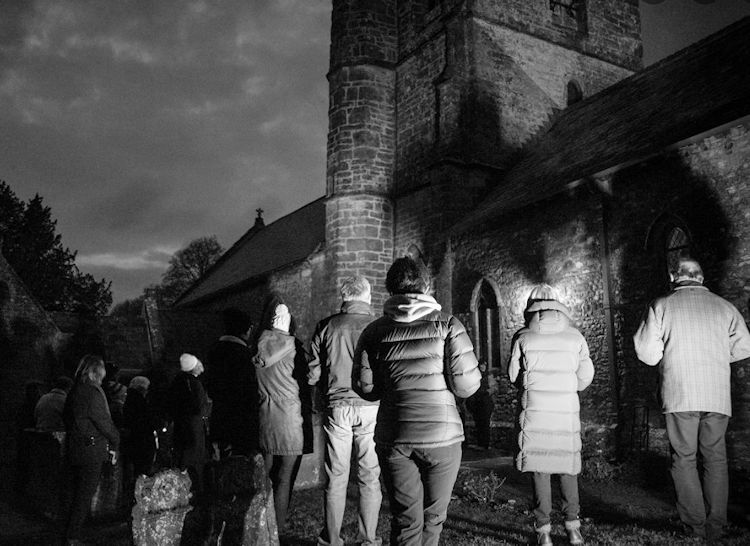For Winsham the impact on social and day-to-day life was limited. The Bell offered hospitality, and many of the hiring's at the Jubilee Hall were exercise based, which was also the case for the newly formed Winsham Community Club. St Stephens were the most heavily hit, with the Church of England taking a very careful approach to mask wearing, social distancing, etc., also introducing the need for lateral flow tests. Click HERE for more details.
Winsham Shop and Post Office was not unduly affected, as it had always encouraged mask wearing ,and hand sanitising, to which most customers adhered .
As with Christmas 2020, a shadow was cast on celebrations, almost without warning. Winsham residents were largely faced with making their own judgements as to what level of risk they should face, depending on their personal circumstances; age, state of health, and normal level of interpersonal interaction between friends and family. And waited.....
In the days leading up to Christmas the rate of new infections from Omicron grew rapidly, reaching in the UK overall, over 100,000 a day, although heavily biased towards the large metropolitan areas such as London. In South Somerset, the official figures showed that at the end of the week Dec15 to 21,that 88% of population aged 12 years plus had been fully vaccinated (as eligible), 98% of Over 70s, and 80% of Under 50s.
The UK government's response to the possibility of a million new cases by early 2022, the projected rate of spread of the Omicron variant, with cases doubling every two to three days, was to offer a 'booster' jab, to all remaining18 million eligible adults. A distribution rate of a million doses a day would be needed to reach this target. A very large reallocation of resources was needed, with the army being drafted in to help.
 St. Stephen's annual Christmas Carol Service was held outside the church, to minimise the risk of infection. Some other village Christmas events were cancelled. (Picture by D.Vickers) |
The cost and effort to reach such a target would be very heavy, but considered to be a better option to a fourth full 'Lockdown' with its enormous dislocation of economic and social activity especially over the Christmas and New Year period. Hopefully it would also help reduce the pressures on an already hard pressed NHS, by reducing serious cases requiring hospitalisation. Would it work? That was the question of everyone's lips! Could the government achieve such a target a target of a million vaccinations a day?
With Christmas just a week away some better news emerged, suggesting that the English government's policy of three jabs might succeed, although it was still a long way from being certain, and surrounded by much controversy. Research was confirming that although the Omicron variant was much more virulent than the Delta variant, it concluded that the evidence to date indicated that people infected with Omicron are up to two-thirds less likely to end up in hospital, which also meant that the death rate was very much lower than pre-vaccination levels of mortality a year ago. Another bright item of news was that trials of a new anti-viral drug had been successfully completed, and was being distributed to especially vulnerable people showing symptoms of infection, reducing the risk of serious illness. With this news the likelihood of a further full lockdown reduced, but did not disappear.
For Winsham people the mood was one of caution, while remaining positive. Virus fears discouraged some younger people returning from the big towns and cities to see parents ,grandparents, siblings and friends over the Christmas period due to the risk of infecting them; although this caused some sadness, it was generally felt that it demonstrated a good sense of social responsibility, of which all could be proud.
St Stephen's and the Chapel continued to hold services, but with mask wearing and social distancing being observed within the buildings. The Bell and Winsham Community Club also continued to operate within the legal obligations, as did the Jubilee Hall and Winsham Shop and Post Office.
Now at the end of the year, the future of the pandemic is unknown. It is a global disaster, with the poorest countries carrying the worst of the burden; until that is changed many argue that the rest of us will never enjoy any real respite, as new variants develop, representing new threats.
But life goes on! We will all have to learn to live with what nature throws at us. History has taught us that worldwide catastrophes such as major pandemics, other major natural disasters, and world wide wars are often preludes to major social change.
Editors Note: This section of Winsham and the Covid Pandemic was completed at the end of December, 2021. Clearly , the Pandemic still has a long time to run, and future developments will be reported on the Winsham Web Museum web site.